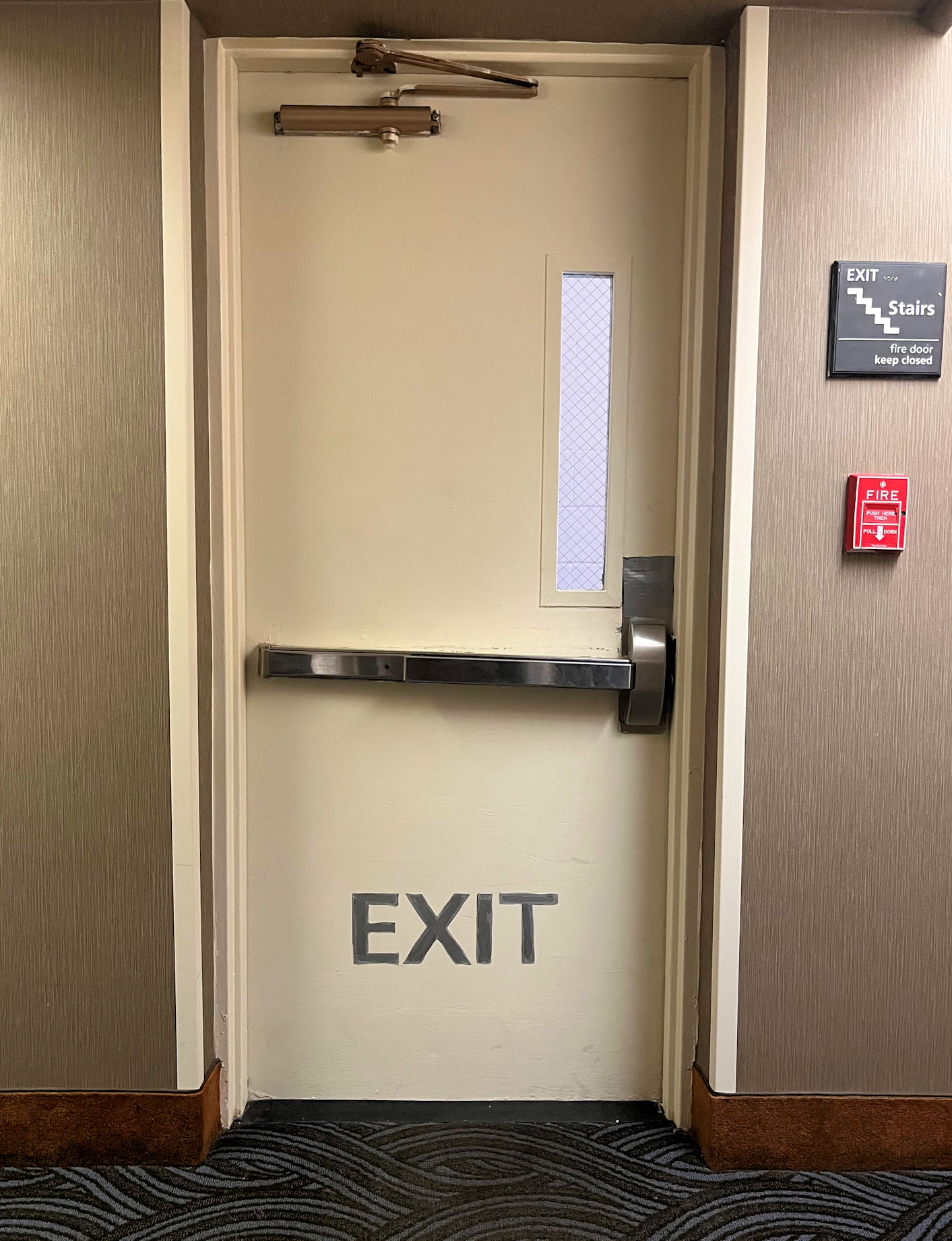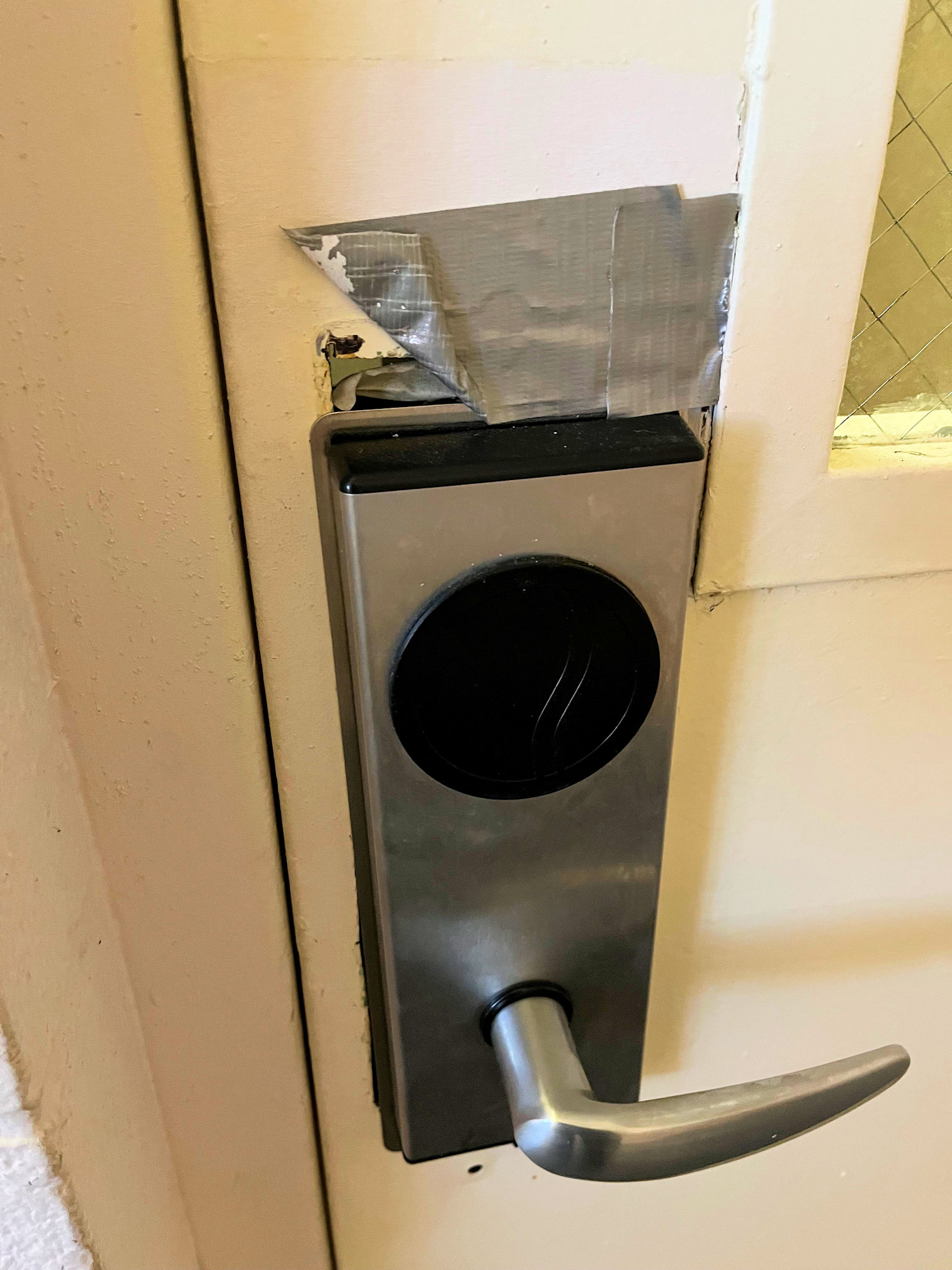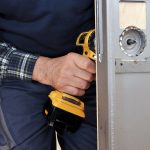Mark Williams of the Partner Alliance for Safer Schools (PASS) sent me this photo of a fire door that had new hardware installed and the existing holes covered with – yes – duct tape. I wish everyone could witness a fire door test in person and see how a code-compliant fire door performs vs. a door like this. There are millions – yes, MILLIONS – of existing fire door assemblies that have been modified or damaged, or that have not been maintained properly. The only way to find them and fix them is to enforce the code requirements for fire door inspections. What’s the hold up?
More quality workmanship…
You need to login or register to bookmark/favorite this content.












So… I’ll ask that exact question “What IS the holdup?”
Money? Number of inspectors? Lack of resources to enforce? Some occupancy types not important enough? I would be curious to know what the general consensus is. It seems to me that having compliant fire doors, in any facility, is just as important as having an elevator in a multi-story building.
In my opinion, the requirement for inspections post installation should be specifically called out in the specifications, not just a general comment for everything to be “code compliant”. Unfortunately, I don’t expect that to go very far as the first person to put that in the specifications is going to get an earful about adding a sizable expense to the project. The worst part is that if it s not done right at the beginning, it will be harder to fix later.
Inspections won’t do anything unless code recognizes practical ways of fixing deficiencies. If a $20 fix would make a fire door work well enough to give building occupants time to evacuate, but code compliance would require a $500 fix, what is an inspector to do? Similar issues arise if a deficiency would not pose any safety risk given the way a space is currently being used,. If it were possible for building inspectors to log a demand for the $20 fix, or require that a space be officially classified and placarded in a manner limiting use unless/until doors are upgraded, then inspections could be useful, but if inspectors can’t demand the most practical remedy and ensure that it gets enforced, they won’t do much good.
Instead of hiring experienced and qualified professional workmen, many hotel/motel owners (such as in this case) will have their second cousin, who probably doesn’t even speak English, install hardware on fire doors. The images speak for themselves. Nice painting work too!
It’s scary. I occasionally visit an old friend in Westmoreland County, PA, and I stay overnight at an economy type motel. There are problems similar to the ones seen in this article and I have pointed them out to the owner, but I may as well talk to the wall. They don’t care because the local AHJ (for whatever reasons) doesn’t cite them, or advise them, to get these kinds of things up to code.
I think part of the what’s the hold up is Us. The whole door people industry. NFPA70 & E is embraced by everyone who touches, specs, services and inspects electricity. Barricade devices on schools was the same. Fire inspectors associations, DHI and lock people all spoke together “they are BAD” DHI took the lead and did the DS&S Foundation. Even got non door people involved like PASS. We all spoke with 1 voice and it was only the occasional outsider and the inventors trying to sell on hype that were not united. With NFPA80 you did not have that. you had Warnock Hersey do there thing and the other big name UL did nothing. DHI did there thing ALOA AIL did something different each for there members. NFPA who wrote the darn thing never even did a certification and did little else then here buy the code. IBC kicked it back to NFPA. There is no PASS or a foundation for the people who died in the firers. I can stand next to a fireman, a parent, a spec writer and a security consultant and all agree don’t chain the doors. On the other hand that same group many would be thinking how much can I charge for a report per door what App should I use. When it comes to NFPA80 some of us even the leadership have become like barricade device inventors.
I don’t disagree with you, John.
– Lori
“It costs too much” and “Building Owners will never stand for it” is what I heard 9 or 10 years ago when I asked local Fire Marshals about what they were doing with enforcement of NFPA annual inspection requirements and reports.
Hi Joel –
The Bronx fire that killed 17 is changing some people’s perspective on that. Last I heard, there were 3 billion dollars in lawsuits in that fire. That would have paid for a lot of inspections and repairs, not to mention 17 people would probably still be here.
– Lori
My expectation is that their insurance carrier will refuse to cover any losses because the building was not in code compliance. Then, the expense will be even larger for the building owner.
How much of a safety risk would these defects pose in practice? Obviously if someone were to blast one side of one of these doors with the conditions created in a door testing facility, they would fail quickly, but I would think that in most real-world fire conditions the doors would still buy building occupants plenty of time to escape, provided only that they are properly closed and latched.
How often do defects like these end up affecting doors’ ability to keep occupants safe?
Hi John –
Normally the deficiencies that result in loss of life are fire doors that don’t close, but it’s a slippery slope if we start trying to pick and choose which deficiencies are dangerous and which ones don’t really matter. Fire doors in the field have to be compliant with NFPA 80 and their listings, or they need to be repaired/replaced.
– Lori
John does have a point. The money making certification bodies (UL, Intertek) do all they can to make more money. If they were to relax some of the rules it would help bring openings up to compliance. Some examples that would help if implemented:
a. Allow an exit device or other hardware over holes previously drilled for different hardware.
b. Remove requirements for UL cert stamp on kickplates, flushbolts, and other steel hardware.
c. Allow HM doors and frames to be labeled/relabeled by any authorized shop that is putting these labels on other metal material without having to be tied to a specific metal MFG.
d. Remove requirements for shop applying all labels.
e. Relax the edge tolerances for reveals, if there is a continuous gap that is within spec around the door in any one plane (stop to door not just frame to door) why couldn’t this pass?
g. More promotion of hold open/unlock systems that are connected to the Fire Alarm.
h. How much does the latching requirement actually impact the safety if there is a closer on it? UK does not require latching, only self closing. This is probably the number one reason doors are propped open. I was shocked to go through stair doors in the UK that had push/pulls but were fire rated. I would think that a building over 3 stories should have self latching hardware on the stairs due to stack pressure but other areas it seems like this could be removed.
Hi Wes –
Thanks for sharing your insight! I know there was some research happening – specifically about fire door clearances. Once we see the outcome of that, we’ll know if it’s safe to increase them.
– Lori
Building owners don’t want to pay for an inspection. Maybe insurance companies should add the fire door inspection to their policy yearly.
I love the way the handle is mounted on the exit trim. Also the friction hold open arm on the closer….